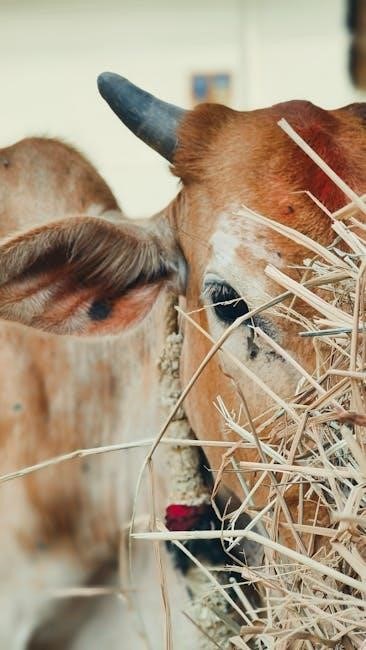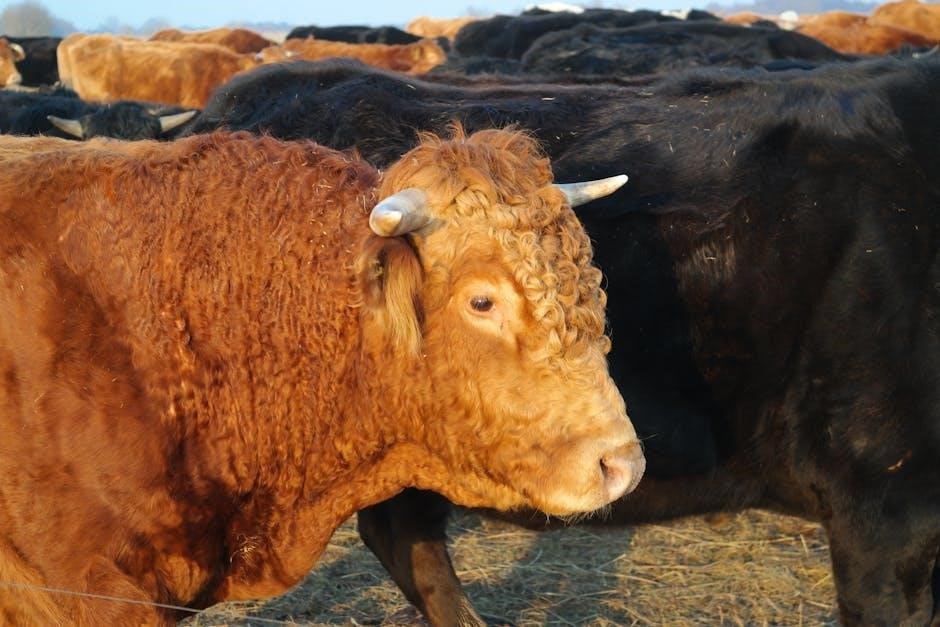LA-200 Dosage for Cattle: An Overview
Understanding the appropriate dosage of LA-200 for cattle is vital for effective treatment. The correct dosage ensures the medication combats bacterial infections effectively and is safe for the animal.
What is LA-200?
LA-200 is a long-lasting‚ broad-spectrum antibiotic used in cattle‚ containing 200 mg of oxytetracycline per ml. It is effective against various diseases‚ ensuring therapeutic blood levels for approximately three days after administration.
Active Ingredient: Oxytetracycline
Oxytetracycline is the active ingredient in LA-200‚ belonging to the tetracycline class of antibiotics. This ingredient works by inhibiting bacterial protein synthesis‚ effectively stopping the growth and spread of susceptible bacteria within the animal’s system. It is a crucial component in treating various bacterial infections in cattle.
The concentration of oxytetracycline in LA-200 is 200 mg per milliliter‚ which allows for a concentrated dose to be administered. It is important to follow the recommended dosage guidelines to ensure the effectiveness of the treatment and to minimize the risk of antibiotic resistance. Proper administration and knowledge of this ingredient are essential for successful treatment.
Broad-Spectrum Antibiotic
LA-200 is classified as a broad-spectrum antibiotic‚ meaning it is effective against a wide range of bacteria. This characteristic makes it a valuable tool in treating various infections in cattle‚ including both gram-positive and gram-negative bacteria. Its broad-spectrum action allows it to combat multiple types of bacterial infections.
The effectiveness against a diverse range of bacteria makes it a practical choice for treating infections where the specific causative agent may not be immediately identified. However‚ it is crucial to consider the potential for antibiotic resistance when using broad-spectrum antibiotics‚ and proper usage guidelines should always be followed. Responsible antibiotic use is vital.
Long-Lasting Formulation
LA-200 is formulated to provide prolonged therapeutic effects following a single administration‚ distinguishing it from other antibiotics requiring more frequent dosing. This long-lasting action is achieved through a specific formulation that allows for a slow and sustained release of oxytetracycline into the animal’s system. This extended release ensures therapeutic levels of the antibiotic are maintained in the blood for an extended period‚ typically around three days.
The benefit of a long-lasting formulation is reduced handling and stress for the cattle‚ as fewer injections are needed. It also improves compliance with the treatment regimen‚ as a single dose provides extended coverage. This reduces the need for frequent administrations.

Indications for LA-200 Use in Cattle
LA-200 is indicated for treating various bacterial infections in cattle. It effectively addresses conditions like pneumonia‚ pinkeye‚ footrot‚ and anaplasmosis‚ providing broad-spectrum antibiotic coverage for livestock.
Treatment of Bacterial Pneumonia (Shipping Fever)
Bacterial pneumonia‚ commonly known as shipping fever‚ poses a significant threat to cattle health‚ particularly in stressed or transported animals. LA-200 is frequently employed to combat this respiratory ailment. It works against the bacterial pathogens often associated with pneumonia‚ such as Pasteurella species. The long-lasting formulation of LA-200 ensures sustained therapeutic levels‚ aiding in the recovery process. A single dosage of 9 mg of oxytetracycline per pound of body weight has proven effective. Early treatment with LA-200 is crucial to minimize lung damage and improve the overall prognosis for cattle affected by shipping fever‚ preventing long-term complications. Proper administration and dosage are vital for success.
Treatment of Pinkeye
Pinkeye‚ or infectious bovine keratoconjunctivitis (IBK)‚ is a prevalent and highly contagious ocular disease in cattle‚ often caused by Moraxella bovis. LA-200 is an effective treatment option due to its broad-spectrum antibiotic properties. The application of LA-200 helps control the bacterial infection‚ reducing inflammation and promoting healing of the affected eye. The recommended dosage of 4.5 ml per 100 lbs bodyweight‚ or 9 mg of oxytetracycline per pound‚ aids in combating the infection. Early intervention with LA-200 can prevent severe corneal damage and vision impairment. Proper administration and adherence to recommended dosages are crucial for the successful treatment of pinkeye and to minimize the spread of infection within a herd‚ ultimately improving animal welfare and productivity.
Treatment of Footrot
Footrot‚ an infectious disease affecting the feet of cattle‚ commonly involves bacterial pathogens such as Fusobacterium necrophorum and Dichelobacter nodosus. LA-200 is valuable for treating footrot due to its antibiotic action against these bacteria. Administering LA-200 helps reduce inflammation‚ pain‚ and further tissue damage. The recommended dosage of 4.5 ml per 100 lbs bodyweight‚ or 9 mg of oxytetracycline per pound‚ when given intramuscularly or subcutaneously‚ combats the infection effectively. Early treatment with LA-200 is crucial to prevent the spread of infection. In addition to antibiotic treatment‚ proper hoof trimming and maintaining a clean environment are essential for managing and preventing footrot. Following the correct dosage protocol ensures optimal therapeutic outcomes‚ leading to improved animal health and welfare.
Treatment of Anaplasmosis
Anaplasmosis‚ caused by the bacterium Anaplasma marginale‚ affects cattle by infecting red blood cells‚ leading to anemia. LA-200‚ containing oxytetracycline‚ is effective in managing anaplasmosis because of its broad-spectrum antibiotic properties. A single dosage of 9 mg of oxytetracycline per pound of body weight is often recommended for treating anaplasmosis effectively. Administering LA-200 helps control the spread of the bacteria and reduces the severity of the disease. Early intervention is crucial to prevent severe anemia and potential fatalities. In addition to antibiotic treatment‚ supportive care‚ such as providing adequate nutrition and reducing stress‚ can aid in recovery. Regular monitoring of cattle in endemic areas and strategic use of LA-200 can help manage and prevent outbreaks of anaplasmosis‚ ensuring herd health.

LA-200 Dosage Guidelines for Cattle
Accurate dosing is critical. The general guideline is 4.5 ml per 100 lbs of bodyweight. Alternatively‚ administer 9 mg of oxytetracycline per pound. Follow veterinary advice.
Standard Dosage: 4.5 ml per 100 lbs Bodyweight
The standard recommended dosage for LA-200 in cattle is 4.5 ml per 100 lbs of bodyweight. This dosage is commonly used for treating various bacterial infections‚ including pneumonia‚ pinkeye‚ and footrot. Administer LA-200 via intramuscular or subcutaneous injection‚ following proper injection techniques to minimize discomfort and ensure effective absorption.
It is crucial to accurately determine the animal’s weight to avoid underdosing or overdosing. Underdosing may lead to ineffective treatment‚ while overdosing can cause adverse reactions. Consult with a veterinarian for precise dosage recommendations based on the specific condition being treated and the overall health of the cattle.
Alternative Dosage: 9 mg of Oxytetracycline per lb Bodyweight
As an alternative to the standard dosage‚ LA-200 can be administered at a rate of 9 mg of oxytetracycline per pound of body weight. This dosage is particularly useful for treating severe bacterial infections‚ such as bacterial pneumonia and anaplasmosis. Clinical trials have demonstrated its effectiveness when administered as a single dose.
This method ensures a concentrated dose‚ offering prolonged therapeutic effects; Careful calculation of the required volume is essential to avoid complications. Always consult a veterinarian to determine if this higher dosage is suitable for the specific health condition and individual animal needs‚ considering potential risks and benefits.

Administration Routes
LA-200 can be administered through several routes. These routes include intramuscular‚ subcutaneous‚ and intravenous injections. The choice depends on the condition and the animal’s health status.
Intramuscular (IM) Injection
Intramuscular (IM) injection is a common method for administering LA-200 to cattle‚ as it allows for relatively rapid absorption into the bloodstream. The neck region is often preferred. Proper technique is crucial to minimize discomfort and prevent tissue damage.
When using the IM route‚ ensure the needle is of appropriate gauge and length for the animal’s size and muscle mass. Administer the injection deep into the muscle. Avoid major blood vessels and nerves to prevent complications.
It is important to follow the recommended dosage guidelines based on the animal’s weight. Never exceed the maximum injection volume per site‚ as specified on the product label‚ to ensure safe and effective treatment.
Subcutaneous (SQ) Injection
Subcutaneous (SQ) injection is an alternative method for administering LA-200 to cattle. This method involves injecting the medication under the skin but not into the muscle. The SQ route generally results in slower absorption compared to intramuscular injections.
When using the SQ route‚ tent the skin and insert the needle at an angle. Ensure the medication is deposited under the skin; The neck region is also a common site for SQ injections in cattle.
Always follow the recommended dosage guidelines based on the animal’s weight. Do not exceed the maximum injection volume per site‚ as specified on the product label‚ to ensure safe and effective treatment. Proper technique is essential to prevent adverse reactions and ensure optimal drug absorption.
Intravenous (IV) Injection (Beef and Dairy Cattle)
Intravenous (IV) injection of LA-200 is permissible for both beef and dairy cattle‚ offering rapid delivery into the bloodstream. This method ensures quick therapeutic levels‚ crucial in severe infections. However‚ IV administration demands precise technique to avoid complications.
Administering LA-200 intravenously requires a skilled veterinarian or experienced personnel. The jugular vein is commonly used. Ensure the needle is correctly placed within the vein to prevent perivascular injection.
Slow injection is vital to minimize the risk of adverse reactions. Monitor the animal closely during and after the injection. Always adhere to the recommended dosage‚ considering the animal’s weight. Proper IV technique maximizes effectiveness and ensures the animal’s safety during treatment.

Important Considerations
When administering LA-200‚ several key factors must be considered to ensure both the animal’s well-being and the safety of the food supply. Always follow guidelines carefully.
Maximum Injection Volume per Site
To minimize discomfort and prevent tissue damage in cattle‚ adhere to maximum injection volumes per site. For cattle‚ it is generally recommended not to administer more than 10 ml at a single intramuscular or subcutaneous injection site. In small calves‚ limit the volume to 1-2 ml per site to avoid irritation. Divide the total dosage into multiple injection sites if necessary to comply with these volume restrictions. Proper injection technique and site selection are crucial for effective treatment and minimizing adverse reactions. Always consult veterinary guidelines for specific recommendations based on the animal’s size and condition‚ ensuring safe administration.
Withdrawal Period Before Slaughter
The withdrawal period before slaughter is a critical consideration when using LA-200 in cattle intended for meat production. This period ensures that antibiotic residues in the animal’s tissues are below the established safe levels for human consumption. Typically‚ the withdrawal period for LA-200 is at least 28 days prior to slaughter. Adhering to this timeframe is essential for compliance with food safety regulations and to protect public health. Always consult the product label and veterinary advice to confirm the precise withdrawal period‚ as it may vary depending on dosage and administration route. Failure to observe can result in penalties.
Milk Withholding Period
For dairy cattle treated with LA-200‚ observing the milk withholding period is mandatory to prevent antibiotic residues from entering the milk supply. This period specifies the time that must elapse after the last LA-200 administration before the milk can be safely used for human consumption. The standard milk withholding period for LA-200 is often around 96 hours‚ but confirmation via the product label and veterinary guidance is crucial‚ as this may vary. Ignoring the milk withholding period can lead to contamination of dairy products and regulatory penalties. Ensure proper record-keeping and communication with all personnel involved in milk production to maintain safety.